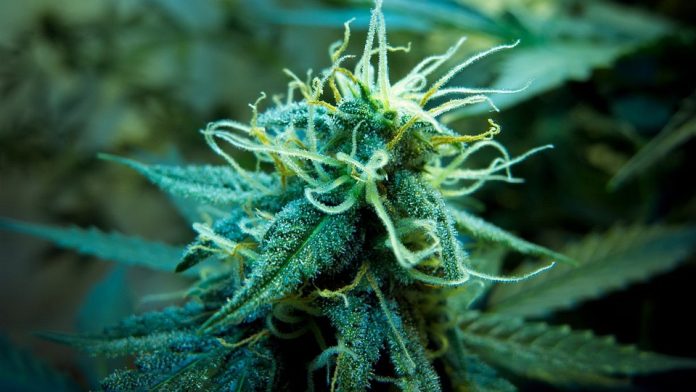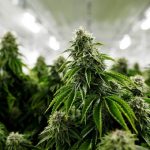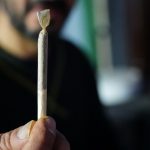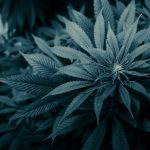If you have ever looked closely at a cannabis flower, you might have noticed a layer of tiny crystals covering the plant’s leaves and buds. These crystals are normally very shiny and sticky and give off the strong and distinct smell of that cannabis strain.
But if you were to look even more closely at these crystals through a microscope, you would discover that they aren’t really crystals at all — they are small resin-coated growths that protrude out of the plant material like little spikes or hairs. These are the plant’s trichomes, named from the Greek word “Tríchōma,” meaning “growth of hair.”
What are trichomes?
Cannabis plants are not the only plants to have trichomes. In the wild, plants such as the tree nettle grow hair-like trichomes to deter herbivores from grazing on them. The same is true for cannabis plants growing in the wild; the strong aroma and bitter taste from the resinous trichomes makes the plant unpalatable to most animals. These trichomes also serve to protect plants against UV rays, strong winds, and fungal spores.
Then there are the types of cannabis trichomes that act as resin glands and are responsible for producing the hundreds of cannabinoids, terpenes, and flavonoids that make the cannabis plant so unique.

Microscope images of capitate-stalked (left), capitate sessile, and bulbous glandular (right) trichomes. Credit: Samuels Lab/UBC
These are three types of glandular trichome that appear commonly on the cannabis plant.
- Bulbous trichomes are the smallest of the three types and can only be seen through a microscope. They normally measure only around 10-15 microns. For scale, the width of a human hair is approximately 70 microns.
- Capitate sessile trichomesare slightly larger, measuring approximately 20-30 microns. Unlike the roughly spherical bulbous trichomes, the capitate sessile trichomes take on a mushroom-like shape, with a trichome ‘head’ attached to the plant by a very short base.
- Capitate-stalked trichomes are large enough to see with the human eye. These trichomes have a longer stalk (around 200-300 microns tall) made from epidermal and hypodermic cells and a spherical resin gland (or “capitate”) at the tip.
How important are trichomes to cultivators?
The appearance of these glandular trichomes will often change as the plant grows and matures. For the majority of the plant’s life, these trichome glands will be colorless and clear. As the plant matures, they will start to become more opaque and milky, before turning an amber/red color.
Generally, the presence of milky/cloudy trichomes indicates a plant that is producing its peak amounts of THC. As the trichomes turn amber, the resin glands produce slightly less THC, but will begin to hold increasingly higher levels of the cannabinoid CBN as the older THC begins to naturally degrade into this.
These color changes in the trichome glands can be used by cultivators to determine whether a plant is ready for harvest or not. There is no clear consensus on exactly when a plant is “ready” though, this changes from cultivator to cultivator based on exactly what properties they want their crop to have.
Some cultivators report that it is best to harvest indica plants when the trichomes are milky but before any turn amber. Inversely, for sativa plants or hybrids that require longer flowering times, cultivators will wait until around 30 percent of the glands have turned to amber before harvesting. Any longer and consumers can expect major changes in taste and in the subjective experience of the cannabis high.
Do all trichomes produce cannabinoids?
Cannabis plants do feature several other types of trichomes in addition to the three mentioned above, but these are non-glandular trichomes. These are the hair-like or claw-like trichomes which are used for plant defense. And as they have no resin glands, they do not possess the right biological parts to produce cannabinoids.
All glandular trichomes – the bulbous, capitate sessile, and capitate-stalked trichomes – are capable of producing cannabinoids and terpenes. However, they do not all produce cannabinoids to the same extent.
In 2019, researchers from the University of British Columbia discovered that the capitate-stalked trichomes are the richest source of THC- and CBD-forming metabolites, and the largest producers of terpenes.
Using a newly-developed multi-photon microscopy technique, the researchers studied the trichomes under UV light and discovered that the capitate-stalked trichomes contained large disc-shaped deposits of secretory cells, while the smaller capitate sessile trichomes had significantly smaller secretory discs.
“We saw that stalked glandular trichomes have expanded “cellular factories” to make more cannabinoids and fragrant terpenes,” explained study author Sam Livingston, in a statement. “We also found that they grow from sessile-like precursors and undergo a dramatic shift during development that can be visualized using new microscopy tools.”
The researchers suggest that such UV light tools could be developed and used by cultivators, who would gain valuable insight on their plants’ maturity.
Can cultivators boost trichome production?
Given that trichomes are the powerhouses of cannabinoid production, it is no surprise that cultivators have begun to look for ways to boost their production.
One of the most common ways this is done is through stress training. There are a variety of different ways in which this stress is introduced, but the basic principle relies on redistributing the plant’s hormones more evenly across its top buds. This in turn should boost yields, and therefore trichome production, across the crop.
Since light is a fundamental part of a plant’s ability to photosynthesize and grow, the lighting conditions in a cannabis grow room can also be manipulated. Some growers keep their plants in total darkness for 24-to-48 hours to increase the number of trichomes and change the plant’s flavor, but studies have yet to provide conclusive evidence that this method works. More commonly, growers will expose their plants to UV-B radiation. While this produces no real physiological or morphological in the plant, studies have demonstrated that UV-B radiation exposure can boost THC levels in mature leaves.
At the most basic level, cultivators can maximize the trichome production and subsequent cannabis resin yield by simply growing healthy plants. Nutrient deficiencies will impact the growth and maturing of trichomes, and so cultivators should keep an eye on plant nutrition and be prepared to administer extra nutrient supplements if necessary.
Fuente: https://www.analyticalcannabis.com/articles/the-science-of-cannabis-trichomes-313105







